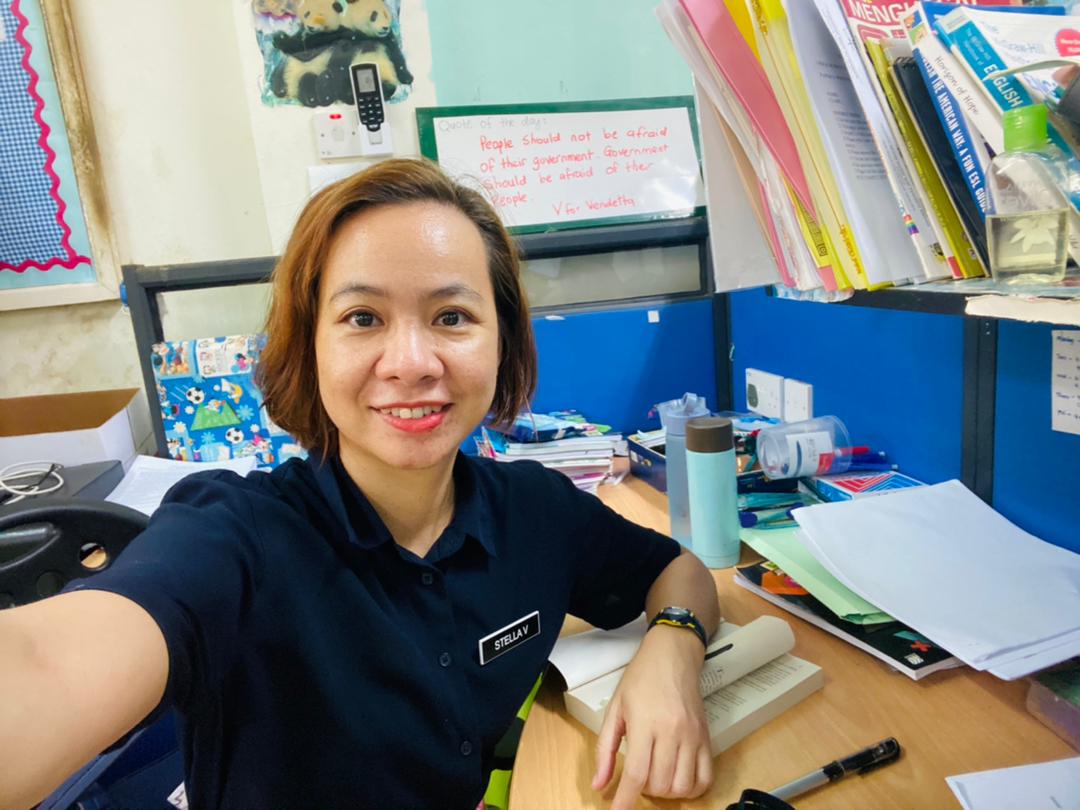|
by Stella Veronica Bulugu Summary This article relates my personal experience as a teacher, conducting remote teaching during the pandemic. Teaching students who mainly come from lower socioeconomic background in the district of Semporna in Sabah, Malaysia has put me in a deep reflective mode. This article is an honest sharing of the mental burdens and emotional turmoils I had undergone during those very challenging times. This article ends with some recommendations on how education leaders and district education offices can play a more active role in supporting teachers' mental and emotional well-beings in this unprecedented time. Caught in the same storm, but not in the same boat I remember the first phase of the Movement Control Order back in March 2020, when it was announced that we were going to shift to virtual schooling. Schools were closed almost immediately, and right after the announcement, we were inundated with endless instructions from my school and the education authorities to urge the implementation of remote learning. It was chaotic. I was underprepared and my students were having difficulties, too. As most of them came from economically-challenged families, the urgent retooling of learning would put an extra pressure on them, as buying additional devices and internet data regularly would cost more than the already straitened family budget. At the same time, my head was full with questions of whats and hows: what am I going to do with the students? How do I contact them? Do all of them have devices? What am I going to teach? How are they going to learn? I was anxious, restless and lost. I was stuck in my hometown without any resources as I had left all my teaching materials in Semporna. But I convinced myself that I got this as I am professionally trained to use education technology tools, and I do actually consider myself proficient in using them in my classroom. I believe that teachers who are already familiar with integrating technology in their lessons would have the same optimism; that it can be done. However, in reality, optimism was barely enough, and I found my confidence breaking apart. To be honest, during the first month of remote learning, I had breakdowns because I was overwhelmed with the situation. The remote learning commenced right after the first semester school break, so there was hardly a chance to manage my students’ contact details and to properly set up the virtual classrooms. On top of feeling lost and severely unprepared to face the changes, I realised that these sudden adjustments ‘mentally numbed’ me. It took me some time to recover and to reorganise myself before I could process the tons of instructions from the school administrators and all of the education offices. Although I was comforted by the thought that I was not alone and that other teachers were having the same problems too, I couldn’t help but feel inadequate. As the saying goes, we all may be caught up in the same storm but we are certainly not in the same boat. For some teachers who are proficient users of technology, the shift could be manageable but for some who are not fully equipped, it was like learning to swim in an open sea. You see, effective teaching is not just about using amazing videos and cool audios with the integration of 3D animation and bots taking attendance. It is about making meaningful learning experiences. And this is already hard enough in face-to-face instructions. Imagine doing it virtually where you cannot ‘see’ your students’ body language and their responses to your instruction. The struggles became personal, and this made teaching and learning more difficult. ...effective teaching is not just about using amazing videos and cool audios with the integration of 3D animation and bots taking attendance. It is about making meaningful learning experiences. The issues of remote learning began to make headlines in the newspapers and sadly, they were mostly frustrations directed at teachers. I am sure everyone has seen the complaints and even cruel jokes about ‘cikgu makan gaji buta’ on social media. Parents were complaining that teachers merely posted links or uploaded pictures on WhatsApp group chats without doing any ‘actual teaching,’ and hence unnecessarily burdening their children with all sorts of meaningless assignments. But they forgot that teachers, too, were struggling and were trying their best to adhere to the plans and instructions imposed by the education authorities. During those times, I have never felt so alone and confused about my own direction as a teacher. I felt like I was left ‘alone’ to defend myself. I was tempted to publish everything I did in the classroom on social media just to show to the public that I was doing my job and also to lament about the problems with the virtual lessons. But I knew better. Retaliating with your disturbed emotion is not going to help make things better. So just like the thousands of other teachers, I did my best to handle it ‘quietly’. I know this critical period is not just about us, the teachers, as students and their families are heavily impacted as well. But teachers are the most important element for an education to happen. Just as there are efforts to provide equipment and infrastructures for the students, there is every need to confront the issue of ‘teacher’s breakdowns’ too. I am saddened by the fact that in Malaysia, teachers seem to be expected to ‘quietly’ handle everything on their own. I have personally witnessed the struggles of working mothers who are also teachers, having to deal with their children all by themselves because their spouses are working in different states. I have listened to some of my colleagues’ experiences of having panic attacks, anxieties and emotional disturbances. However, I have not seen teachers taking it out on newspapers or making headlines by talking openly about their struggles, unlike in Western countries. Maybe it was because we are all being pressured to bottle up everything as showing emotional breakdown is considered as a failure. To suffer from a breakdown during this critical period is perfectly normal, as teachers - just like everyone else - have feelings too. None of us anticipate this ‘full force’ attack. We suddenly found ourselves in the midst of these chaos, being forced to search for the best ways and to struggle to adapt. I read an article about teachers quitting over heavy workloads and stress in one of the schools in the United Kingdom. One of the teachers described how she had worked extra hours to prepare for lessons, to conduct classes and to ensure students are learning while at the same time had to struggle to manage her family to the point that she could not sleep for days. This resulted in her being signed-off for a three-week break and prescribed with antidepressants. Her situation is somewhat relatable in a way; no one is immune from the emotional impact this pandemic brings, not even teachers. Retaliating with your disturbed emotion is not going to help make things better. So just like the thousands of other teachers, I did my best to handle it ‘quietly’. Teachers’ well-being was something that no one comprehensively talks about in the mainstream media during these times. Yes, there were plenty of talks and webinars on teachers' mental health but to my knowledge there had been almost no in-depth discussions about it. There was also no teacher’s helpline support established. It was not a pleasant experience to be put under pressure to perform in spite of the unprecedented challenges. And to make matters worse, when schools finally reopen, every teacher would certainly be expected to work harder to make up for students' ‘learning loss’ and to keep up with other piling workloads. The constant pressures imposed by the state department, district office and school administration did not help to make the shifts better. If anything, the excessive workloads and inefficient process worsened the situation. The pandemic is indeed the greatest test for our education system. Fortunately, the toughest storm has passed and there is no use crying over spilt milk now. It is time for us to nurture resilience in the system and to move forward by empowering our teachers and addressing their mental health. Here are some takeaways that I have learned from my breakdowns. Establishing support group in the district education office There should be an aggressive and more concerted effort from the district education office to establish a strong and effective support group to help the teachers who are in need of managing their stress. This support group can comprise of experienced teachers as well teachers who are registered school counsellors. Through this group, help and support will be accessible to the teachers. This support group could offer a safe space to discuss, to have conversations and if it is needed, to request for necessary actions. Experiencing emotional breakdowns does not necessarily equate suffering from clinical depression. It could also be a situational or temporal stress, which makes it all the more important to address to prevent it from developing into a more serious emotional disturbance. Having a safe space, being able to have discussions about it and getting support from colleagues can help teachers to recharge and to feel motivated to march on. Many teachers are very much self-motivated and self-driven, but there are times when teachers would be affected by external triggers such as students’ struggles, excessive workloads and inefficient school administrations. Education office can collaborate with any NGOs to set up a helpline for teachers who need emotional support. For example, in the United Kingdom, Education Support Partnership (ESP) is a charity body that offers mental health support to anyone who works in the education field. There are a number of NGOs in Malaysia that offer mental health support, so maybe they can work with the education district office to provide expert assistance in this area. Empowering Critical Friends Group among Teachers Critical Friends Group (CFG) is one of the tools in the Professional Learning Community that I found practical during the critical period of the pandemic. The CFG led by the Semporna School Improvement Specialist Coach for English has become a great support system for the English teachers here in Semporna. The weekly meetings and Google Meet sessions we had during the school closure became the space for us to discuss, to have conversations and to share our burdens together. Through the sessions, not only did we share about our teaching practices, materials, and resources, we also shared our feelings and concerns and discussed different issues in the education with zero judgement. It was an amazing collaborative effort among the teachers to help each other during the difficult times. As for me, this group has been my safe space to ask for help, ideas and share my thoughts. Through this group, I realised that no teachers should be left alone in shouldering the weight of their duties and responsibilities. We need to work together and to share each other’s burdens. This practice should be encouraged among teachers. Relevant, specific and efficient professional development courses on EdTech I have to concur with Eileen Belastock, the Director of Technology and Information at Nauset Public Schools Massachusetts. In her article on how to improve teacher training for more successful remote learning, Belastock argues that teachers have the most significant impact on student learning, but without ongoing support and training, individual educators cannot take full ownership of technology-enhanced education. Our teachers need high quality training on how to use the tools properly, and not on just receiving instructions to do some selected or fixed applications. There should be a thorough data observation to determine specific measures to encounter the different access levels of the students and the schools. This pandemic has urged teachers to instantly learn, to be familiar with multiple digital tools and to teach at the same time. This is multitasking at a whole new level. However, we need to be reminded that we are in a position where there is already scarcity and poverty, so shoving all kinds of courses will not equip the teachers overnight. Formerly, this was the cause of chaos and breakdowns. There should be a proper plan and time for teachers to sit down and thoroughly undergo proper training. Not just ‘multitask’ during training. Professional development courses should be specific and relevant to address different needs of the teachers and students. This pandemic has urged teachers to instantly learn, to be familiar with multiple digital tools and to teach at the same time. This is multitasking at a whole new level. You cannot pour from an empty cup This pandemic has indeed changed the way I see myself as a teacher; my limitations and the things that I should improve. It also reminds me to take good care of myself so I can work better to help my students. For how can I help my students when I cannot even help myself? How do I convince my students that we can pull this together if I cannot even convince myself? How can I not be wondering about this when the public put the students' performance as the ultimate judgment for the quality of work a teacher has done? Whether one likes it or not, once you are a public-school teacher, your actions and words will constantly be under public scrutiny. Everything can be used against you. However, as a loving society, we should redirect this scene. I long to see a society that can normalise open initiatives to resolve mental health issues just like we openly resolve other public health issues. Teachers are not immune to mental illnesses. We must openly discuss it and provide help to the teachers. It takes a village to raise a child, but the village is not made up of teachers only. Education authorities, parents, school administrators, please know this: teachers and students are desperately trying. Nothing good will ever be achieved if they are broken inside. To my fellow teachers out there: your strength is unquestionable, but you are also human. Sometimes it is good to ask ‘how am I doing?” and to take a break, to give yourself a space to breathe. Remember, you cannot pour from an empty cup, so take care of yourself first. Published on 12 April 2021 AuthorStella Veronica Bulugu is an English teacher at SMK Datuk Haji Panglima Jakarullah, Semporna. Apart from being a teacher, she loves to be known as a diver, a marathoner, an aspiring painter who adores the works of Bob Ross, Claude Monet & George Surat, a massive fan of Taylor Swift musics and a nature photography enthusiast. Stella is also passionately involved in social and community works. She has been collaborating with different NGOs, social enterprises and initiatives concerning literacy, fighting period poverty among school girls, mental health, marine education and conservation as well as education access to stateless children. She is the co-founder of the One Pad One Love Initiative (an initiative to end period poverty). She was also one of the fellows for the International Leaders in Education Programme (2017) under the Bureau of Educational and Cultural Affairs, US Department of State and completed the fellowship at the Center for Advanced Studies in Global Education, Mary Lou Fulton Teachers College, Arizona State University. Stella can be contacted at [email protected] Love this article? Check out our blog for more like this! Interested in contributing an article? Send us a message!
1 Comment
Peter
4/27/2021 03:04:00 am
I feel heard, understood & represented. This should be a commonplace; people being able to talk about experiences to the fullest without being 'edited' in fear of offending 'some parties'. I mean, we're working towards equality & equity, & freedom of speech is definitely the way to go. Thank you Miss Stella for speaking up on our behalf, thank you for bringing such an issue to light & thank you 'going digital elt' for this feature.
Reply
Leave a Reply. |
Categories
All
|



